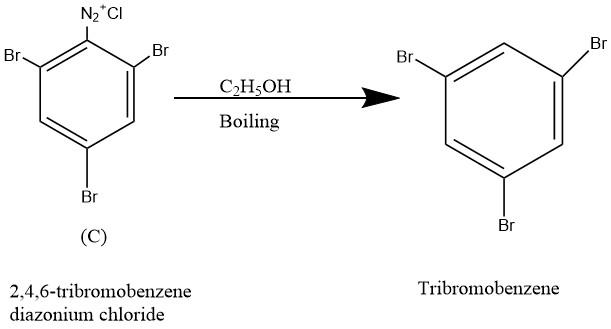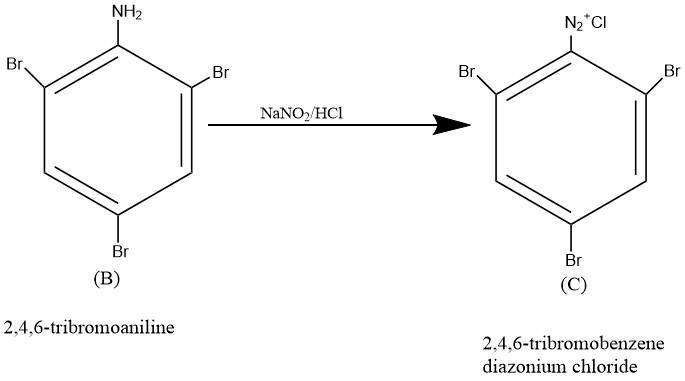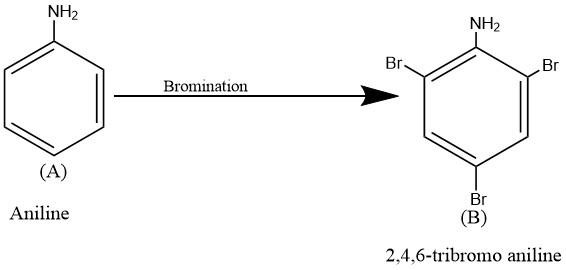
In the following reaction the product B is
\[A\xrightarrow{Bro\min ation}B\xrightarrow{NaN{{O}_{2}}/HCl}C\xrightarrow[{{C}_{2}}{{H}_{5}}OH]{Boiling}tribromobenzene\]
A. Salicylic acid
B. Benzoic acid
C. Phenol
D. 2,4,6-tribromoaniline
Answer
566.1k+ views
Hint: In the given question, we have given that there are three sequences of organic reactions. First reaction is a bromination, second one is diazotization and the third one is boiling in presence of ethyl alcohol
Complete step by step answer:
The tribromobenzene can be obtained from diazonium salt by boiling with ethyl alcohol. Thus the compound C could be 2,4,6-tribromobenzene diazonium chloride. The reaction is given below;

The compound 2, 4, -tribromobenzene diazonium chloride(C) could be prepared by diazotization if \[2,\text{ }4,\text{ }6-tribromoaniline\left( B \right)\] with \[NaN{{O}_{2}}/HCl\] at low temperature. The reaction is given below;

The compound \[2,\text{ }4,\text{ }6-tribromoaniline\] (B) could be obtained by bromination of aniline group. Hence, the compound A could be aniline.the reaction is given below

From these steps we got that the product B is \[2,\text{ }4,\text{ }6-tribromoaniline\]
The complete reaction sequence can be represented as follows

So, the correct answer is Option D.
Note:
Bromination of both phenol and aniline is very difficult to control, with di-, and tri-bromo products forming readily. Because of their high nucleophilic reactivity, aniline phenol undergoes substitution reactions with iodine, a halogen that is normally unreactive with benzene derivatives. In the question the reactions occur in a step by step manner. Starting with bromination of aniline , then diazotization of tribromoaniline and ends with tribromobenzene
In the solution the sequence of reactions starts with aniline. Like aniline there are several benzene derivatives(functional groups attached in benzene) such as phenol, carboxylic acid which gives different products in respective steps.so, we have to be aware of such things
Complete step by step answer:
The tribromobenzene can be obtained from diazonium salt by boiling with ethyl alcohol. Thus the compound C could be 2,4,6-tribromobenzene diazonium chloride. The reaction is given below;

The compound 2, 4, -tribromobenzene diazonium chloride(C) could be prepared by diazotization if \[2,\text{ }4,\text{ }6-tribromoaniline\left( B \right)\] with \[NaN{{O}_{2}}/HCl\] at low temperature. The reaction is given below;

The compound \[2,\text{ }4,\text{ }6-tribromoaniline\] (B) could be obtained by bromination of aniline group. Hence, the compound A could be aniline.the reaction is given below

From these steps we got that the product B is \[2,\text{ }4,\text{ }6-tribromoaniline\]
The complete reaction sequence can be represented as follows

So, the correct answer is Option D.
Note:
Bromination of both phenol and aniline is very difficult to control, with di-, and tri-bromo products forming readily. Because of their high nucleophilic reactivity, aniline phenol undergoes substitution reactions with iodine, a halogen that is normally unreactive with benzene derivatives. In the question the reactions occur in a step by step manner. Starting with bromination of aniline , then diazotization of tribromoaniline and ends with tribromobenzene
In the solution the sequence of reactions starts with aniline. Like aniline there are several benzene derivatives(functional groups attached in benzene) such as phenol, carboxylic acid which gives different products in respective steps.so, we have to be aware of such things
Recently Updated Pages
Why are manures considered better than fertilizers class 11 biology CBSE

Find the coordinates of the midpoint of the line segment class 11 maths CBSE

Distinguish between static friction limiting friction class 11 physics CBSE

The Chairman of the constituent Assembly was A Jawaharlal class 11 social science CBSE

The first National Commission on Labour NCL submitted class 11 social science CBSE

Number of all subshell of n + l 7 is A 4 B 5 C 6 D class 11 chemistry CBSE

Trending doubts
Differentiate between an exothermic and an endothermic class 11 chemistry CBSE

10 examples of friction in our daily life

One Metric ton is equal to kg A 10000 B 1000 C 100 class 11 physics CBSE

Difference Between Prokaryotic Cells and Eukaryotic Cells

1 Quintal is equal to a 110 kg b 10 kg c 100kg d 1000 class 11 physics CBSE

State the laws of reflection of light




